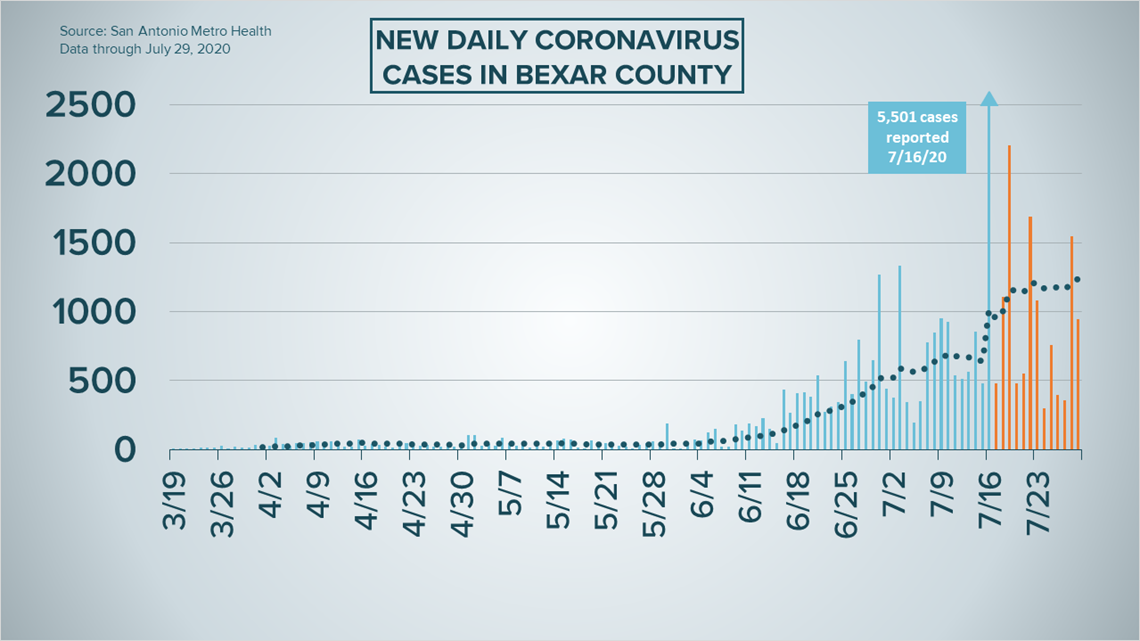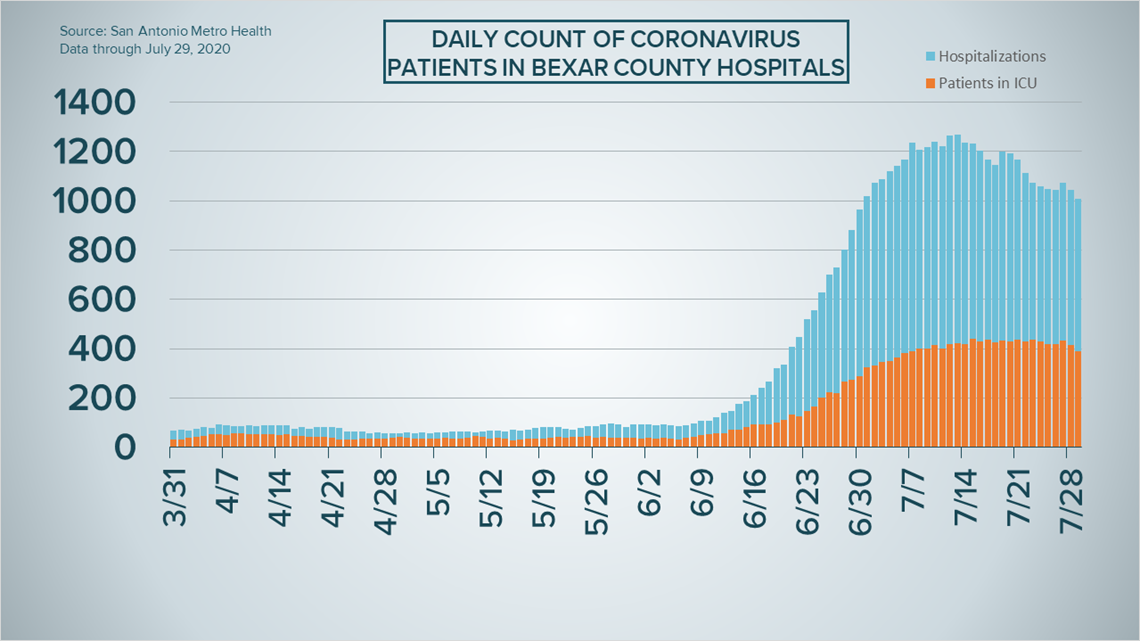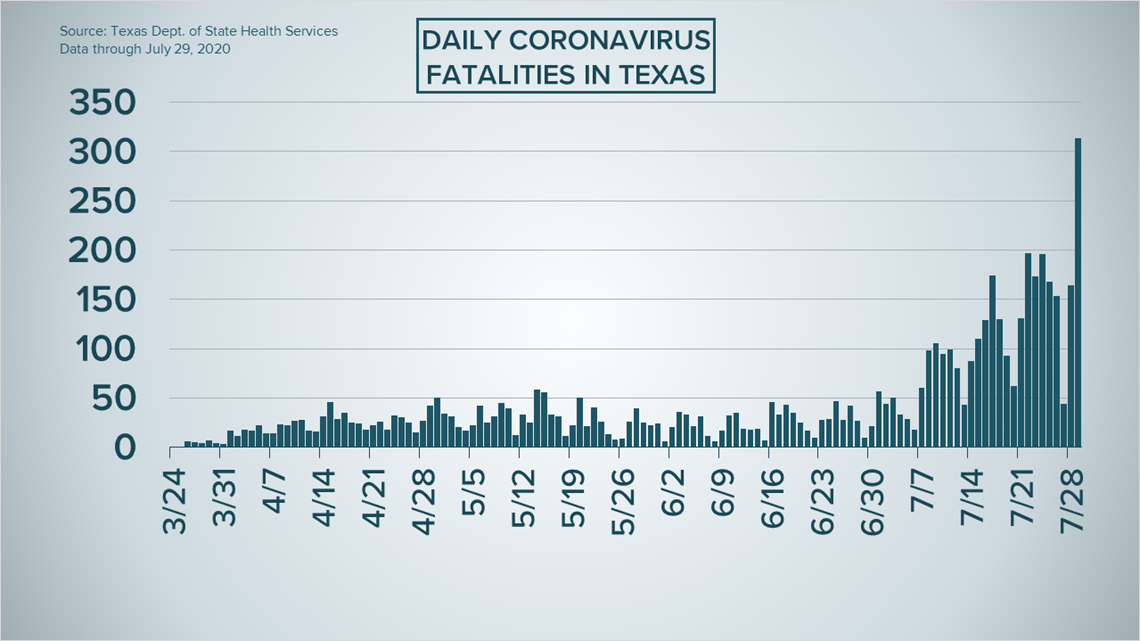SAN ANTONIO — We're tracking the latest numbers from the coronavirus pandemic in San Antonio and across Texas. Here are the latest numbers reported by Bexar and surrounding counties:
- Bexar County: 946 new cases and seven additional fatalities from COVID-19 were reported Wednesday. There have been a total of 38,930 cases as the county death toll rises to 342.
- Comal County: The county reported 44 new cases on Wednesday and seven more deaths related to COVID-19. There have been a total of 2,101 cases and 52 deaths as of Wednesday evening. County officials said there are 1,121 active coronavirus cases; 928 county residents have recovered, as of Wednesday.
- Hays County: As of July 29, the Hays County Local Health Department confirms there are at least 2,935 active lab-confirmed cases of COVID-19. Since Hays County first started providing numbers, a total of 4,276 lab-confirmed cases have been reported, including 25 deaths. As of July 29, the Hays County Local Health Department has received 21,297 negative test results.
How Bexar County is trending
We're tracking how many coronavirus cases are confirmed in Bexar County each day from the time San Antonio Metro Health began reporting cases more than five months ago. Graphing those daily case numbers along a 14-day moving average provides an accurate picture of the curve in the San Antonio area and the direction we're heading amid the coronavirus.
On Wednesday, Mayor Ron Nirenberg reported 946 new cases of the novel coronavirus in Bexar County, for a total of 38,930 COVID-19 cases in the county. Meanwhile, Nirenberg said there had been seven additional virus-related deaths in the county. The death toll is now up to 342.
The county has averaged 768 new cases a day over the last week. Bexar County Judge Nelson Wolff noted the local positivity rate is around 16%.


Hospitalizations continue to trend downwards; as of Wednesday evening, 1,007 patients remain hospitalized in Bexar County; 389 patients are in the ICU, while 269 patients are on ventilators.
12% of staffed hospital beds in the county are available, while 40% of the county's ventilators are available.


Coronavirus in Texas
Texas reported 9,042 new COVID-19 cases and 313 deaths Wednesday, bringing the state total of cases to more than 400,000, and the total deaths to more than 6,000.
The Department of State Health Services posted the numbers on its dashboard shortly before 4 p.m.


The 313 newly reported deaths are the largest number the state has seen since the pandemic began; however, the state also changed its method of collecting death data on Monday of this week, looking at death certificates. Prior to that change, the single-day high of reported deaths was 197.
According to the state's cumulative deaths chart, Texas tallied its 6,000th death on July 21.


On July 17, Texas crossed the 300,000 case mark, reporting 307,572 total. Twelve days later, the state crossed the 400,000 mark.
The state's seven-day average positivity rate sits at 12.55 percent, which means for every eight people tested, at least one tests positive for coronavirus. The positivity rate has been on a downward trend since July 16, when it was 17.43 percent.
Latest Coronavirus Headlines
- State legislators from both parties ask Texas governor to delay STAAR tests
- Need your kid to virtually learn somewhere else? There's a place for that.
- Schools in Bexar County prepare to open for in-person classes, setting up standoff with local health authority
- Hays County reports 2,935 active COVID-19 cases, 25 deaths
- UT Austin asks students to self-quarantine for 14 days before arrival
- Confirmed deaths from the coronavirus in the US hit 150,000
Coronavirus symptoms
The symptoms of coronavirus can be similar to the flu or a bad cold. Symptoms include fever or chills, cough, shortness of breath or difficulty breathing, fatigue, muscle or body aches, headache, new loss of taste or smell sore throat, congestion or runny nose, nausea or vomiting and diarrhea, according to the Centers for Disease Control.
Most healthy people will have mild symptoms. A study of more than 72,000 patients by the Centers for Disease Control in China showed 80 percent of the cases there were mild.
But infections can cause pneumonia, severe acute respiratory syndrome, kidney failure, and even death, according to the World Health Organization. Older people with underlying health conditions are most at risk.
On June 25, the CDC expanded the list of groups at a higher risk of severe illness due to coronavirus.
Experts determined there was consistent evidence these conditions increase a person's risk, regardless of age:
- Chronic kidney disease
- COPD (chronic obstructive pulmonary disease)
- Obesity (BMI of 30 or higher)
- Immunocompromised state (weakened immune system) from solid organ transplant
- Serious heart conditions, such as heart failure, coronary artery disease, or cardiomyopathies
- Sickle cell disease
- Type 2 diabetes
The CDC believes symptoms may appear anywhere from two to 14 days after being exposed.
Human coronaviruses are usually spread...
- Between people who are in close contact with one another (within about 6 feet).
- Through respiratory droplets produced when an infected person coughs, sneezes or talks. These droplets can land in the mouths or noses of people who are nearby or possibly be inhaled into the lungs.
- Some recent studies have suggested that COVID-19 may be spread by people who are not showing symptoms.
Help stop the spread of coronavirus
- Stay home when you are sick.
- Eat and sleep separately from your family members
- Use different utensils and dishes
- Cover your cough or sneeze with your arm, not your hand.
- If you use a tissue, throw it in the trash.
Lower your risk
- Wash your hands often with soap and water for at least 20 seconds. If soap and water are not available, use an alcohol-based hand sanitizer.
- Avoid touching your eyes, nose, and mouth with unwashed hands.
- Avoid close contact with people who are sick.
- Clean and disinfect frequently touched objects and surfaces.
- The CDC recommends wearing a mask or cloth face covering if you have to be out due to an essential service or essential activity such as going to the grocery store.
- If you are 60 or over and have an underlying health condition such as cardiovascular disease, diabetes or respiratory illnesses like asthma or COPD, the World Health Organization advises you to try to avoid crowds or places where you might interact with people who are sick.

